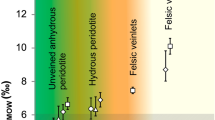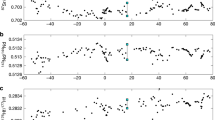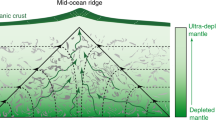Abstract
Variations in the 187Os/188Os isotopic signature of mantle and mantle-derived rocks have been thought to provide a powerful chemical tracer of deep Earth structure. Many studies have inferred from such data that a long-lived, high-rhenium component exists in the deep mantle (187Re is the parent isotope decaying to 187Os, with a half-life of ∼42 billion years), and that this reservoir probably consists of subducted oceanic crust1,2,3. The interpretation of these isotopic signatures is, however, dependent on accurate estimates of rhenium and osmium concentrations in all of the main geochemical reservoirs, and the crust has generally been considered to be a minor contributor to such global budgets. In contrast, we here present observations of high rhenium concentrations and low Yb/Re ratios in arc-type melt inclusions. These results indicate strong enrichment of rhenium in undegassed arc rocks, and consequently the continental crust, which results in a crustal estimate of ∼2 p.p.b. rhenium, as compared to previous estimates of 0.4–0.2 p.p.b. (refs 4, 5). Previous determinations of rhenium in arc materials, which were largely measured on subaerially erupted samples, are likely to be in error owing to rhenium loss during degassing. High mantle-to-crust rhenium fluxes, as observed here, require a revaluation of geochemical models based on the 187Re-187Os decay system1,2,3.
This is a preview of subscription content, access via your institution
Access options
Subscribe to this journal
Receive 51 print issues and online access
$199.00 per year
only $3.90 per issue
Buy this article
- Purchase on Springer Link
- Instant access to full article PDF
Prices may be subject to local taxes which are calculated during checkout



Similar content being viewed by others
References
Hauri, E. H. & Hart, S. R. Rhenium abundances and systematics in oceanic basalts. Chem. Geol. 139, 185–205 (1997)
Walker, R. J., Prichard, H. M., Ishiwatari, A. & Pimentel, M. The osmium isotopic composition of convecting upper mantle deduced from ophiolite chromites. Geochim. Cosmochim. Acta 66, 329–345 (2002)
Bennett, V. C., Nutman, A. P. & Esat, T. M. Constraints on mantle evolution from 187Os/188Os isotope compositions of Archean ultramafic rocks from southern West Greenland (3.8 Ga) and Western Australia (3.46 Ga). Geochim. Cosmochim. Acta 66, 2615–2630 (2002)
Esser, B. K. & Turekian, K. K. The osmium isotopic composition of the continental crust. Geochim. Cosmochim. Acta 57, 3093–3104 (1993)
Peucker-Ehrenbrink, B. & Jahn, B. Rhenium-osmium isotope systematics and platinum group element concentrations; loess and the upper continental crust. Geochem. Geophys. Geosyst. 2,2001GC000172 (2001)
Sun, W. D., Bennett, V. C., Eggins, S. M., Arculus, R. J. & Perfit, M. R. Rhenium systematics in submarine MORB and back-arc basin glasses: Laser ablation ICP-MS results. Chem. Geol. (in the press)
McDonough, W. F. & Sun, S.-s. The composition of the Earth. Chem. Geol. 120, 223–253 (1995)
Rudnick, R. L. & Fountain, D. M. Nature and composition of the continental crust; a lower crustal perspective. Rev. Geophys. 33, 267–309 (1995)
Becker, H. Re-Os fractionation in eclogites and blueschists and the implications for recycling of oceanic crust into the mantle. Earth Planet. Sci. Lett. 177, 287–300 (2000)
Morford, J. L. & Emerson, S. The geochemistry of redox sensitive trace metals in sediments. Geochim. Cosmochim. Acta 63, 1735–1750 (1999)
Jaffe, L. A., Peuker-Ehrenbrink, B. & Petsch, S. T. Mobility of rhenium, platinum group elements and organic carbon during black shale weathering. Earth Planet. Sci. Lett. 198, 339–353 (2002)
Korzhinsky, M. A., Tkachenko, S. I., Shmulovich, K. I., Taran, Y. A. & Steinberg, G. S. Discovery of a pure rhenium mineral at Kudriavy Volcano. Nature 369, 51–52 (1994)
Ishihara, S. Rhenium contents of molybdenites in granitoid-series rocks in Japan. Econ. Geol. Bull. Soc. Econ. Geol. 83, 1047–1051 (1988)
Alves, S., Schiano, P., Capmas, F. & Allègre, C. J. Osmium isotope binary mixing arrays in arc volcanism. Earth Planet. Sci. Lett. 198, 355–369 (2002)
Alves, S., Schiano, P. & Allègre, C. J. Rhenium-osmium isotopic investigation of Java subduction zone lavas. Earth Planet. Sci. Lett. 168, 65–77 (1999)
Woodland, S. J., Pearson, D. G. & Thirlwall, M. F. A platinum group element and Re-Os isotope investigation of siderophile element recycling in subduction zones: Comparison of Grenada, Lesser Antilles Arc and the Izu-Bonin Arc. J. Petrol. 42, 171–198 (2002)
Lassiter, J. C. & Luhr, J. F. Osmium abundance and isotope variations in mafic Mexican volcanic rocks: Evidence for crustal contamination and constraints on the geochemical behavior of osmium during partial melting and fractional crystallization. Geochem. Geophys. Geosyst. 2 2000GC000116 (2001)
Chesley, J. T., Ruiz, J., Righter, K., Ferrari, L. & Gomez-Tuena, A. Source contamination versus assimilation: An example from the Trans-Mexican Volcanic Arc. Earth Planet. Sci. Lett. 195, 211–221 (2002)
Borg, L. E., Brandon, A. D., Clynne, M. A. & Walker, R. J. Re-Os isotopic systematics of primitive lavas from the Lassen region of the Cascade Arc, California. Earth Planet. Sci. Lett. 177, 301–317 (2000)
Righter, K., Chesley, J. T. & Ruiz, J. Genesis of primitive, arc-type basalt: Constraints from Re, Os, and Cl on the depth of melting and role of fluids. Geology 30, 619–622 (2002)
Bennett, V. C., Norman, M. D. & Garcia, M. O. Rhenium and platinum group element abundances correlated with mantle source components in Hawaiian picrites; sulphides in the plume. Earth Planet. Sci. Lett. 183, 513–526 (2000)
Lassiter, J. C. Evidence for Re loss during magma degassing: Implications for Re concentration variations in OIB and MORB. Eos 83(47) (Fall Meet. Suppl.), 1447 (2002)
Eggins, S. M. Origin and differentiation of picritic arc magmas, Ambae (Aoba), Vanuatu. Contrib. Mineral. Petrol. 114, 79–100 (1993)
Kamenetsky, V. S., Crawford, A. J., Eggins, S. M. & Muehe, R. Phenocryst and melt inclusion chemistry of near-axis seamounts, Valu Fa Ridge, Lau Basin; insight into mantle wedge melting and the addition of subduction components. Earth Planet. Sci. Lett. 151, 205–223 (1997)
Kamenetsky, V. S. et al. Parental basaltic melts and fluids in eastern Manus backarc basin; implications for hydrothermal mineralisation. Earth Planet. Sci. Lett. 184, 685–702 (2001)
Sylvester, P. J. & Eggins, S. M. Analysis of Re, Au, Pd, Pt and Rh in NIST glass certified reference materials and natural basalt glasses by laser ablation ICP-MS. Geostand. Newsl. 21, 215–229 (1997)
Barth, M. G., McDonough, W. F. & Rudnick, R. L. Tracking the budget of Nb and Ta in the continental crust. Chem. Geol. 165, 197–213 (2000)
Peucker-Ehrenbrink, B. & Hannigan, R. E. Effects of black shale weathering on the mobility of rhenium and platinum group elements. Geology 28, 475–478 (2000)
Hofmann, A. W. Mantle geochemistry; the message from oceanic volcanism. Nature 385, 219–229 (1997)
Schiano, P., Birck, J. L. & Allègre, C. J. Osmium-strontium-neodymium-lead isotopic covariations in mid-ocean ridge basalt glasses and the heterogeneity of the upper mantle. Earth Planet. Sci. Lett. 150, 363–379 (1997)
Acknowledgements
We thank M. Kamenesky, C. Allen and J. M. G. Shelley for help with sample preparation and laser ablation ICP-MS analyses. We also thank S.-s. Sun for discussions that initiated this work, and D. G. Pearson for comments and suggestions that improved the manuscript. W.S. was supported by an Australian international graduate student scholarship.
Author information
Authors and Affiliations
Corresponding author
Ethics declarations
Competing interests
The authors declare that they have no competing financial interests.
Supplementary information
Rights and permissions
About this article
Cite this article
Sun, W., Bennett, V., Eggins, S. et al. Enhanced mantle-to-crust rhenium transfer in undegassed arc magmas. Nature 422, 294–297 (2003). https://doi.org/10.1038/nature01482
Received:
Accepted:
Issue Date:
DOI: https://doi.org/10.1038/nature01482
This article is cited by
-
Mobility of rhenium and selenium during chemical weathering and their implication for petrogenic organic carbon oxidation
Science China Earth Sciences (2024)
-
Rhenium solubility and speciation in aqueous fluids at high temperature and pressure
Progress in Earth and Planetary Science (2023)
-
Rhenium Distribution and Behavior in the Salinity Gradient of a Highly Stratified Estuary and Pristine Riverine Waters (The Krka River, Croatia)
Archives of Environmental Contamination and Toxicology (2021)
-
Plate subduction, oxygen fugacity, and mineralization
Journal of Oceanology and Limnology (2020)
-
Re–Os isotope evidence from Mesozoic and Cenozoic basalts for secular evolution of the mantle beneath the North China Craton
Contributions to Mineralogy and Petrology (2017)
Comments
By submitting a comment you agree to abide by our Terms and Community Guidelines. If you find something abusive or that does not comply with our terms or guidelines please flag it as inappropriate.



